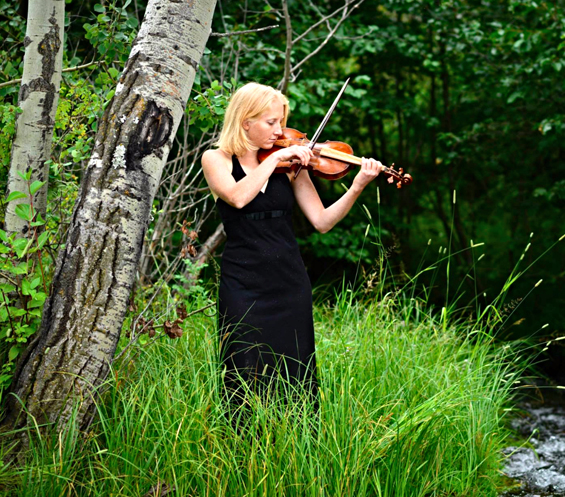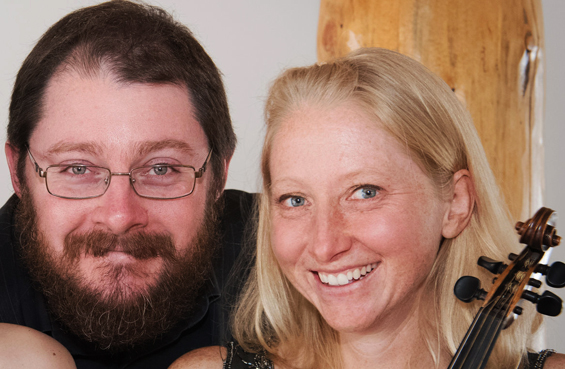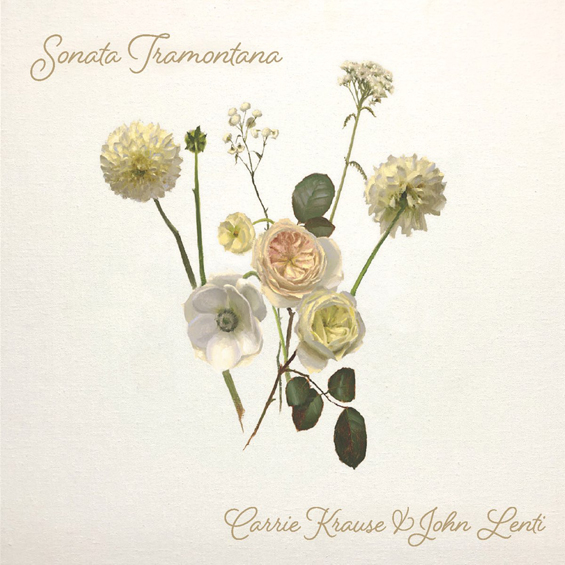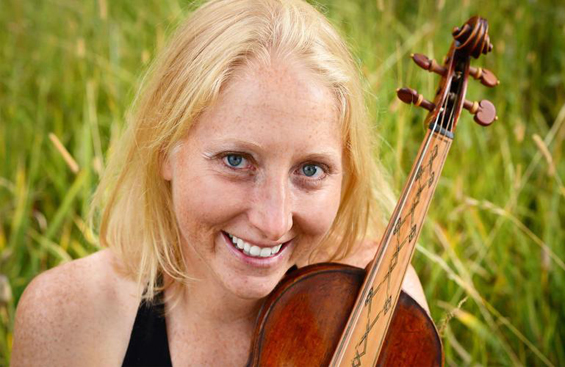

photo: Lighted Path Photography
FIVE QUESTIONS WITH CARRIE KRAUSE
Baroque music might have originated in northern Italy five hundred years ago, but when performed by violinist and Bozeman Symphony concertmaster Carrie Krause and other Baroque Music Montana (BaMM) members in an intimate Montana setting it sounds as fresh as if born yesterday. She founded BaMM in 2015 and as its Artistic Director has witnessed since then an exponential increase in interest in Baroque music, from the number of artists associated with the organization to the concerts she and her colleagues have given, be it in a house, backyard, church, or park. Certainly one reason for its timeless character has to do with the period instruments involved, including the Baroque violin and theorbo she and her long-time musical partner John Lenti play on their debut duo release Sonata Tramontana (reviewed here). No better argument for the musical style and its practitioners is needed than this wonderful recording, which features pieces by Böddecker, Castaldi, Biber, Schmelzer, and others and naturally formed the main topic of discussion in this recent interview. Having attended Carnegie Mellon University, the Cleveland Institute of Music, and Juilliard, she's ventured far from home, but no connection runs deeper than the one she has with Montana, where she lives in the foothills of the Gallatin mountain range and teaches violin students when not performing or enjoying the outdoors.

photo: Lighted Path Photography
1. The presence of Tramontana in the album title is important with respect to how deeply the recording is grounded in a particular place and draws for inspiration from that setting. Could you elaborate on that and also explain in what way Sonata Tramontana is a "love letter to Montana”?
Tramontana refers to the wind that blows over the Alps, and its second meaning is the winds of change. The pieces from the Italian and German Alpine regions of the seventeenth century are particularly well suited to our unusual duo of baroque violin and theorbo. Tramontana was a neat link between the region of seventeenth century music we love with Baroque Music Montana, the concert series which supports the performances of John and me, as most of our nearly 100 concerts together these years take place in the Rocky Mountain west.
Montana is a very unusual place for a baroque concert series, yet our series has created countless performance and relationship opportunities that have been the greatest gift to the development of our duo, uniquely intimate style, and risk-taking. Part of the reason John and I play so much together is because we adore the opportunity to play rural and tiny concerts for wonderfully appreciative audiences—as the music was originally intended—in this stunningly beautiful, physically challenging, and inspiring place.
2. How is it that you came to play the baroque violin, and could you also clarify what the differences are between the baroque violin and its conventional counterpart?
I was finishing my degree at Carnegie Mellon and craving stylistic freedom. I caught a concert of Chatham Baroque, on period instruments, and was instantly hooked for the fresh, inventive sound, incorporation of dance and ornamentation, elegance, and inspiration from history.
The body of the violin has changed little over 300 years, as the design of surfaces and curves in terms of strength and sound production they happened upon centuries ago was so remarkable. However, what has changed is the hardware on the instrument. The main difference in sound comes from the gut strings from sheep or beef gut, not metal as modern strings. The bridge is lower and flatter, the neck set at less of an angle.
Basically, the evolution of instruments is for greater tone production, to sound more impressive and to sell more tickets in big concert halls! And there were some changes for ease of playing as well, such as the invention of the chin rest and longer fingerboard in the nineteenth century. But those of us in historical performance have other goals…goals of nuance, variety, and speaking through our music rather than evenness and projection.

3. How did you and John meet and decide to play together? When the two of you performed Johann Heinrich Schmelzer's Sonata Terza—the first piece you played together—was there instant chemistry or is that something that had to be nurtured over time?
John and I met playing with Seattle Baroque when we were just beginning our careers, invited by Ingrid Matthews who became an incredible mentor and influence to us both. It's very special to us that she produced this album (and if you listen to the very end of the album, you'll hear all three of us playing on a secret bonus track!). I would say John and I loved playing and spending time together instantly. He's hilarious and charming, and I make things happen. We're both a bit ‘of the woods' and have an affinity for flannel.
4. All eight of the pieces performed on the release are by composers who primarily lived during the 1600s. Have contemporary pieces been written for baroque violin and theorbo and do you perform them, or do you purposefully concentrate on material from that earlier era? Do the eight pieces pose particular challenges for you in performing them, and if so what are they? And are there specific techniques you had to master to play material from that era?
We adore music from the seventeenth century, which focused on the sublime, experimentation, solace, and the collective. There's so much depth of repertoire and many pieces that have never been performed in modern times or are waiting to be discovered in libraries and count's castles. However, John has been known to play a modern concerto on electric theorbo, so one never knows!
The music of the Stylus Fantasticus was from the dawn of secular instrumental writing, with experimentation of form, harmony, and even the instruments used. It is really open, with little indications of how to realize the printed notes, from the bow strokes to ornamentation to sense of timing. Modern players rarely venture here because the language is just so different than what one might encounter in a modern context. It calls for preludes, links, and cadenzas, a special ornament where you skip the bow across the strings called ‘bow vibrato,' rhythmically dotted trills, and very quick bowing. There are different sections in fairly quick succession, either improvisatory, imitative and fugal, or a ‘jam' over a repeated chord progression.

photo: Lighted Path Photography
5. Despite the fact that the pieces were written hundreds of years ago, they sound as if they could have been written yesterday, including perhaps the most beautiful one, the stirring Passacaglia in G minor by Heinrich Ignaz Franz Biber. What is it about this work that makes it strike such a deep emotional chord and draw performers to it so often?
I agree, the Passacaglia is such a touching piece, from a time when sensuousness and emotionalism ran deep. This is the final work in a remarkable collection of fifteen pieces illustrating events in the life of Christ, and the Passacaglia specifically depicts the guardian angel through its always present bassline. I find the notion comforting and melancholy at the same time.
The idea of the personal ego of the romantic wasn't yet in consciousness, but instead a sense of mysticism and the human condition. Loss was rampant in these early times, and people achingly needed beauty and comfort. I believe this is still the purpose of music.
Bonus Question: Sonata Tramontana is the debut album from you and John. Are you already thinking of a follow-up and considering the pieces you might include on it?
It was absolute bliss to create this album, our next album is in the works. We're not yet sure if we want to go with a larger band of musicians to record a collection of works or works not yet released. Or, John and I might not be able to resist the chance to together dive into this adventure again, perhaps with a virtuoso dulcian-player and a tenor added for spice.
website: CARRIE KRAUSE
September 2023![]()